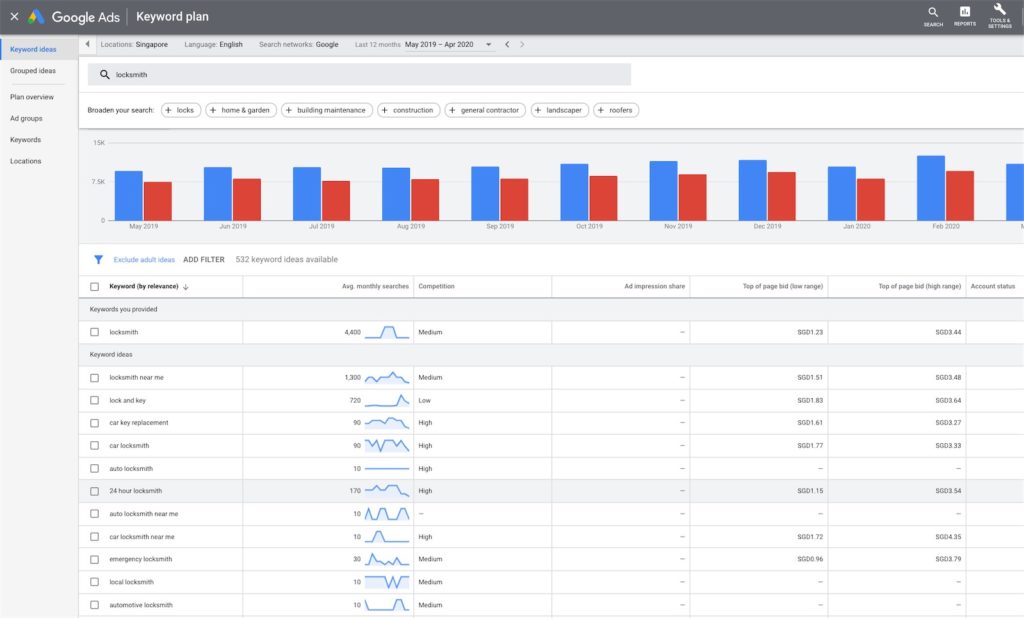The term SEO (Search Engine Optimisation) may sound abstract, especially when the internet is filled with so many jargons — on-page SEO, off-page SEO, technical SEO, and SEO content.
If you Google how to do SEO, you will most probably come by articles with very advanced tactics written by the Internet gurus. While those are great tactics for advanced marketers, they may not be applicable for the many who just need a beginner’s guide.
̛We’ve been in your position where we didn’t know what to do and felt lost reading through the complex terms and instructions. After doing some SEO work, we realised that what’s really needed to kickstart the SEO journey can be drilled down into a few simple steps. So without further ado, let’s get right into it now.
Step 1: Finding keywords for your SEO content
The first step of SEO is knowing what to optimise for. What we mean is finding out the keywords to target. You need to start your SEO process by looking for the right keywords for your website.
How to find the right keywords for your business
There are thousands of tools online that you can use to find keywords for your business. Useful tools such as ahrefs and SEMrush can cost up to hundreds of dollars a month. If you have the budget to spare, you may consider them.
In this article, we will be sharing the free and easy way to find keywords: Google.com and Google Adwords. These 2 platforms are where you can get the most accurate information.
#1. Using Google.com
Take for example; you are in the locksmith business. It is more than likely that people are going to Google “locksmith” to find you. So you hop onto Google and type “locksmith”. These are the suggested results you’ll see:

Google auto-suggests this list of popular keywords as you type. You won’t go wrong targeting these keywords as these are popular searches people look for.
Select a keyword from this list and scroll down to the bottom of the results page.
You’ll see a list of searches related to the specific keyword you selected. Something like this:

These related searches are long-tail keywords you can consider targeting as well.
#2. Using Google Adwords
You can also consider going onto Google Adwords’ Keyword Planner to find keywords. This is a preferred method over Google.com as Google Adwords offer better insights into the search keywords. Learn how to access Google Adwords’ Keyword Planner here.
If you have advertised on Google Ads before, you should have unlocked the keyword planner tool. This tool shows you the exact search volume of certain keywords.

If you are new to this, don’t worry. You’ll still be able to see the search volume, albeit in range instead of absolute numbers. But it is good enough for you to make a decision.

With these 2 tools, you’ll be able to select some popular and high search volume keywords for your website.
Why you should focus on localised keyword for your SEO content

By focusing on localised keywords, you’ll effectively narrow the competition and increase your reach to your target audience. If your locksmith service is islandwide, you’ll still want to target keywords like ‘locksmith tampines’ or ‘locksmith sengkang’ in your content. This way, searchers can find you easily.
The intention of the search should also be considered. As locksmith is considered an “urgent service”, people Googling it would want to access your service as fast as possible. Thus, it’ll make sense for you to target specific locations like “tampines” or “sengkang”.
Here’s give an example of the types of keywords:
| Generic keyword | locksmith |
| Long-tail keyword | locksmith services |
| Localised keyword | locksmith Singapore |
| Localised long-tail keyword | locksmith Singapore price |
| Super localised long-tail keyword | locksmith Singapore near melocksmith tampines |
Sometimes, keywords may not be location-specific. For example:
| Generic keyword | copywriting |
| Long-tail keyword | copywriting services |
| Localised keyword | copywriting Singapore |
| Localised long-tail keyword | copywriting services Singapore |
| Super localised long-tail keyword | does not exist, as the keyword is not location-specific |
Whether localised keywords apply to your business or not, it is essential to have a good grasp of the different types of keywords you can target and learn to prioritise them.
Once you have compiled your keywords, it’s time for the grinding part — producing the content.
Step 2: Producing the SEO content
Now that you have your keywords, it’s time to produce content targeted at these keywords. There are a few things you can consider doing.
#1. Write articles
You can choose to write long-form blog posts bi-monthly (~2,000 words) or regular blog posts (~1,000 words) once every few days.
Want to know the content length that can help you rank higher on Google? Find out here.
Remember that you are producing these articles based on the selected keywords.
If your selected keyword is “locksmith services”, you can write about general types of services, specific kinds of services exclusive to your business, what it includes, and even things to take note when hiring a locksmith.
If your selected keyword is “locksmith Singapore price”, you can write about your pricings, how to look out for unethical prices, or common practices of a reputable locksmith.
You should also produce an infographic along with your article. Infographics help readers retain more information easily than a typical article. It can be shared on your company’s social media to gain more readership to the blog post. In fact, infographics are liked and shared on social media 3x more than any other type of content.
Wondering if publishing more articles will improve your SEO? Read more about it here.
#2. Create website landing pages
You can consider creating a landing page exclusively to your services. For example, for the keyword “locksmith tampines”, you can create a landing page just for services in Tampines.
This page can include testimonials from Tampines residents who have engaged your services and the locksmiths that are serving that area. Content on how long it’ll take and what to expect will also be useful for such landing pages.
As you are producing the landing pages based on the selected keywords, do remember to include them in your meta title, description, and headers.
#3. Expand your homepage content
You should also relook at your homepage content and enhance it. Include your selected keywords in your homepage content, as well as your meta title, description, and headers.
The main reason why it’s important to have your selected keywords in these places is so that both Google and your audience know what it is they are looking at and ensure that they can find you in the list of search results.
Step 3: Set up Google Search Console for tracking

The final step to the beginner’s guide to SEO is to set up your Google Search Console for tracking.
Google Search Console helps you analyse your site’s performance. You can monitor, maintain, and troubleshoot your site’s performance with it.
The earlier content we told you to produce? You can see how often those pages are appearing in the search result pages, and how you can improve them.
For instance, you have created a landing page for “locksmith tampines”. 3 months later, you track the performance via Google Search Console, which returns with high impressions but low clicks. This may mean that you need a better meta title and description to attract your audience to click into your site.
People are searching for that keyword, yes. But why are they not landing on your page? That’s what you’ll need to figure out and strategise on how to improve your content.

